
Content marketing is a fundamental marketing strategy B2B businesses use to attract, convince, and convert their target audience.
And rightly so.
A report published by DemandGen revealed that 67% of B2B buyers base their buying decisions on the content they’ve researched and consumed. Of these, 47% would consume between three and five pieces of content before they reach out and speak with a sales rep.
Yet, only 40% of B2B businesses have a documented content marketing strategy!
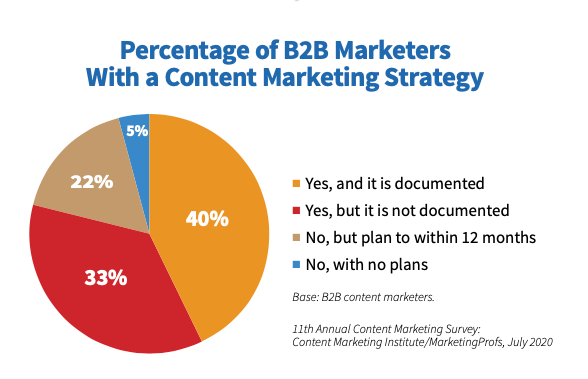

Source: Content Marketing Institute
In this guide, I’ll teach you how to create a content marketing strategy so you can document this and get the results you expect.
But before we get into that, let’s first cover the basics.
What is Content Marketing?
The simplest way I can define content marketing is that it’s a strategy where you publish and distribute helpful and practical content to capture your target market’s attention and convince them to take action.
When B2B business owners, even some B2B marketers, hear this, two things would usually come to mind:
First, it involves publishing articles and guides; second, it’s done online.
That’s only partly true because if you search what content means, here are some definitions you’ll find:
“Something that is to be expressed through some medium, as speech, writing, or any of various arts.” (Dictionary.com)
“[A]ny kind of material that can be read, watched online, on television, or in print.” (Collins Dictionary)
“The ideas, facts, or images that are in a book, article, speech, movie, etc.” (The Britannica Dictionary)
As you can see, content marketing isn’t only limited to online written content. It involves anything you publish on the Internet or traditional media to capture your target market’s attention and get them to take action.
Content marketing’s a strategy where you publish & distribute practical content to capture your target market & convince them to take action. #marketing #contentmarketing #B2BContentMarketing Click To Tweet
B2C vs B2B Content Marketing
While completing my post-graduate certificate in Marketing at one of the top universities in the Philippines, I found it quite interesting that the entire curriculum focused on marketing for business-to-consumer (B2C) businesses.
In fact, there was hardly any case study that we discussed during the entire program that featured a marketing strategy done by a business-to-business (B2B) firm.
So, I conducted my own research and discovered that most content marketing strategies and tips advocated on various platforms and even on the Internet are geared towards B2C firms.
Which now begs the question: Is there a difference between B2C and B2B content marketing?
The short answer to this is: YES!
Sure, both companies are run by people who tend to be driven by their emotions to buy things.
However, in my years as a B2B content marketing consultant, I found four distinct areas where B2B content marketing differs from B2C content marketing.
Target Audience
This is the most obvious difference between a content marketing strategy developed for a B2C and a B2B business.
The products and services B2C businesses promote through their content marketing strategy are designed to meet an individual’s specific wants and needs.
On the other hand, the products and services B2B businesses offer are those targeting other companies.
While some businesses have only one person deciding which products or services to buy, most companies targeted by B2B firms have between 6 and 10 people involved in the decision-making process.
B2C content marketing targets individual people. B2B content marketing needs to convince multiple decision-makers. #marketingtip Click To Tweet
Change Drivers
A change driver is a trigger that influences your target audience to take a specific action.
For B2C customers, emotion is the primary change driver.
B2B buyers, on the other hand, aren’t as emotionally-driven as their B2C counterparts when choosing which product or service to buy.
For them, the top change driver is the return on the investment (ROI) they get from the product or service you offer.
Messaging Intent
Another distinction between B2C vs B2B content marketing is the reason or purpose behind each content published.
As previously mentioned, B2B buyers choose vendors based on how much and how soon they’ll get the return on the product or service they purchase. For them, that means working with the best vendors in their respective fields or industries.
That’s why when it comes to launching a B2B content marketing strategy, each content published should be crafted to position the company’s brand and its leaders as industry experts.
B2C customers, on the other hand, don’t care whether or not the company or its owners are experts in their respective industries. Instead, what triggers them to purchase a product or service is based on how it would make them feel.
In the book How Customers Think: Essential Insights into the Mind of the Market, Professor Gerald Zaltman stated that 95% of consumers buy because of how a product or service would make them feel.
That’s why most B2C companies would incorporate the Fear of Missing Out (FOMO) into their content marketing campaign.
Human beings are social creatures. We crave to belong. When we see our friends rave about a product or service that we don’t have, it can cause us to feel anxious, stressed, and unhappy. The only way to alleviate this feeling is by buying the product or service they see their friends or social media influencers are using.
This desire to belong is also why B2C customers buy from companies that share the same values and principles they hold dear while boycotting those that don’t.
A perfect example of this can be seen in the infamous video Pepsi aired featuring Kylie Jenner that aired at the height of the #BlackLivesMatter movement.
While the entire concept of the video was designed to promote cultural diversity and inclusion, people criticized Pepsi on social media for being “tone-deaf and trivializing” the movement, causing Pepsi to lose up to $5 million in potential sales.
B2B content marketing focuses on thought leadership. B2C content marketing focuses on emotions. #marketingtip Click To Tweet
Content Formats
Although video is now becoming the preferred content format published by B2B and B2C businesses, 85% of B2B buyers state that they still prefer to consume written content.
Text content like long-form blog posts, case studies, and white papers work best because of two reasons:
First, decision-makers are busy. Scanning a written piece of content for the information they need is faster than having to watch a video, regardless of how short it may be.
Second, decision-makers can print out copies of the text content and provide copies to their colleagues during their meetings to decide which solution will best help them achieve their business goals and where to purchase this.
Meanwhile, the best content formats for B2C customers greatly depend on the company’s product or service.
Generally speaking, content that appeals to the senses and emotions like this one from Audrey’s Pastries work best for most B2C businesses.
Steps to Create a B2B Content Marketing Strategy
Step #1: Be Clear About Your Goals
As with any strategy, the first step is to ensure that you’re crystal clear with the end goal you want to achieve with your content marketing strategy.
Are you trying to bring more awareness to your brand?
Or perhaps you want to grow your email list with potential leads?
When creating your goal, ensure it’s a S. M. A. R. T. one. By that, I mean that it’s specific, measurable, achievable,relevant, and time-bound.
Step #2: Define Your Target Buyer Personas
A well-crafted buyer persona goes beyond demographic information like their educational background, income and job title. It also includes educated guesses and speculations about their specific goals, pain points, and buying behavior patterns.
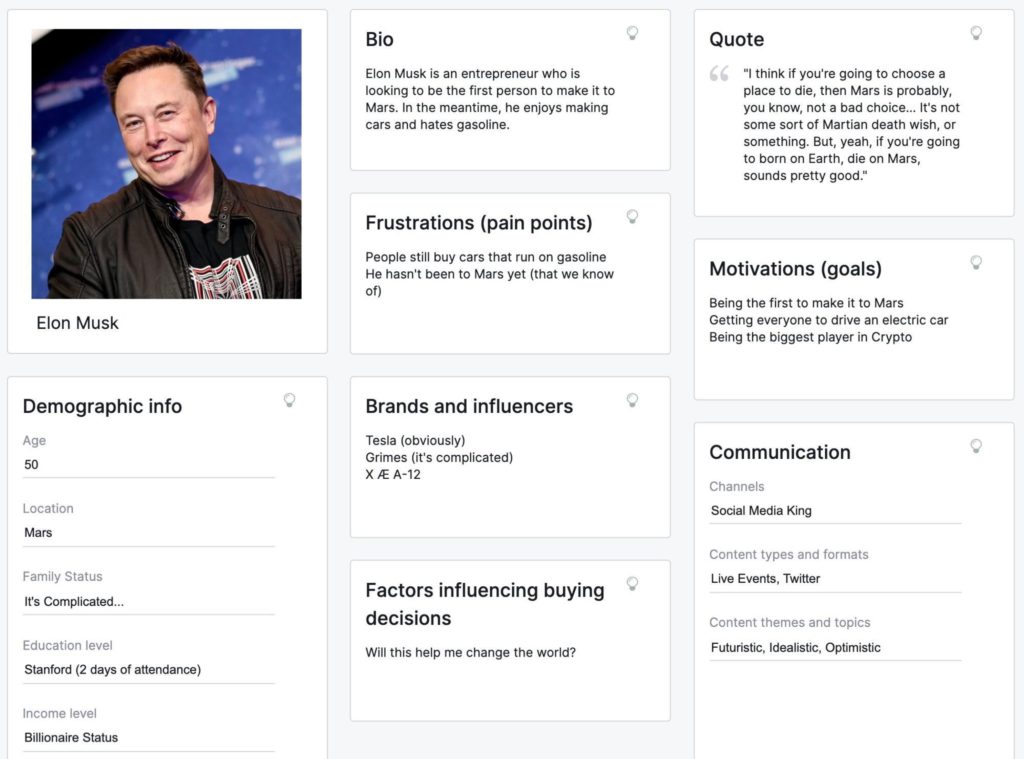

Source: SEMRush
Taking the time to craft your company’s buyer persona will help you know:
- what topics are they interested in,
- what types of content they prefer to consume, and
- where to distribute your content after it’s published.
Step #3: Establish Your B2B Content Marketing Strategy’s KPIs
Key Performance Indicators (KPIs) are values that will help you objectively determine how effective your content marketing strategy is in helping you reach your set goals.
With so much data readily accessible, identifying which KPIs to track will ensure that everyone is on the same page when determining whether your strategy’s working.
Some KPIs you can include in your content marketing strategy are:
- Page Views
- Inbound Links
- Click-Through Rate
- Form Responses
- Conversion Rate
Step #4: Audit Your Existing Content
Conducting a content audit can be tedious, especially if you’ve already published lots of content online.
However, taking the time to audit your existing content will reveal your top-performing content. You can then extend its effectiveness by updating this to ensure that it continues to deliver results.
Another benefit of a content audit is that it prevents you from publishing duplicate content on your website.
Auditing your content also gives you an insight into how your content is distributed across your buyer’s journey to becoming a customer or client.
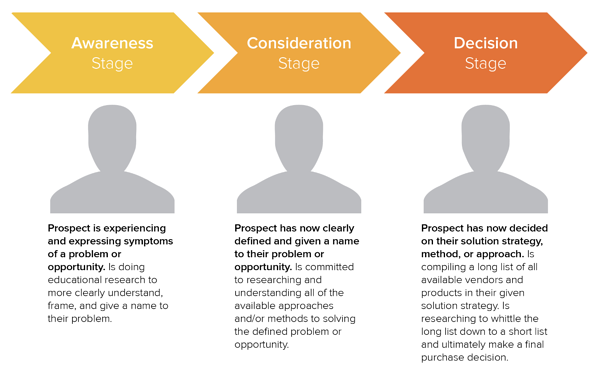

Source: HubSpot
Doing this lets you focus your content creation efforts on the stages with significant content gaps.
Step #5: Study Your Competitors
As the Chinese philosopher Sun Tzu once said:
If you know the enemy and know yourself, you need not fear the result of a hundred battles. If you know yourself but not the enemy, for every victory gained you will also suffer a defeat. If you know neither the enemy nor yourself, you will succumb in every battle.
Analyzing the content published by your direct competitors will ensure you’ll create content that resonates with your target audience while keeping you competitive.
Step #6: Create Your Topic Clusters
In content marketing, a topic cluster refers to a group of content about a specific topic. It’s made of three parts:
- Pillar Page. This long-form article is between 3,000 and 5,000 words long and comprehensively discusses the specific topic.
- Cluster Content. These are shorter pieces of content than a pillar article. However, they provide more in-depth information for each subheading within the pillar article.
- Hyperlinks. These link the cluster content to the pillar page and vice-versa, making it easier for your target audience to dive deeper into any section of the pillar article.
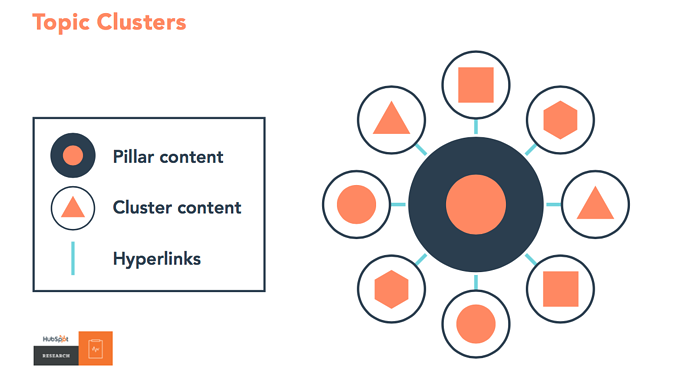

Source: HubSpot
Organizing your content into topics helps boost your site’s search engine rankings in two ways.
First, topic clusters make it easier for your site visitors to find related content, increasing the average time they spend on the page and the page views per visit.
Second, they help you optimize your website based on search intent, which is the purpose or reason behind the search.
When choosing a topic to include in your content strategy, ensure that it’s broad enough that you won’t run out of articles and pieces of content to publish. At the same time, it should be narrow enough so that you can discuss each of the critical points in-depth within your topic clusters.
A tool like SEMRush’s Topic Research can help you in this step.
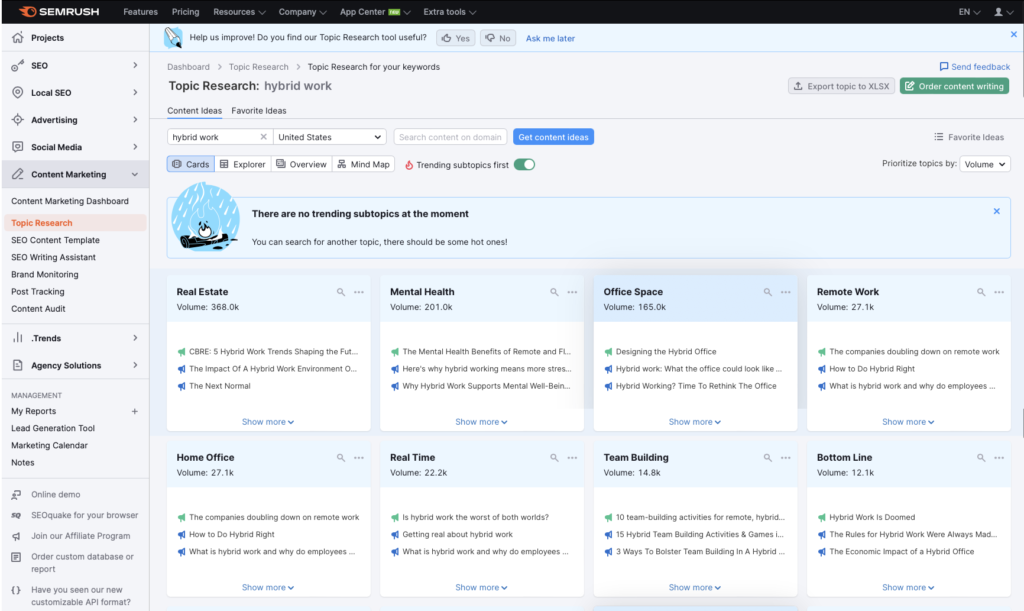

Screenshot of SEMRush’s Topic Research Tool
As you can see, it gives suggestions on the different topic clusters you can create and their corresponding search volumes.
That way, you can create content for the topic clusters your target audience is actively searching for.
Step #7: Conduct Your Keyword Research
Although Google puts a premium on search intent, choosing the right keywords can still make or break your content marketing strategy.
That’s because search bots fetch the content based on the keywords used by people when searching for information, products or services.
One great tool to use here is Team BiQ. It provides a list of keyword phrases, their respective monthly average search volume, and the most prevalent search intent associated with each keyword phrase.
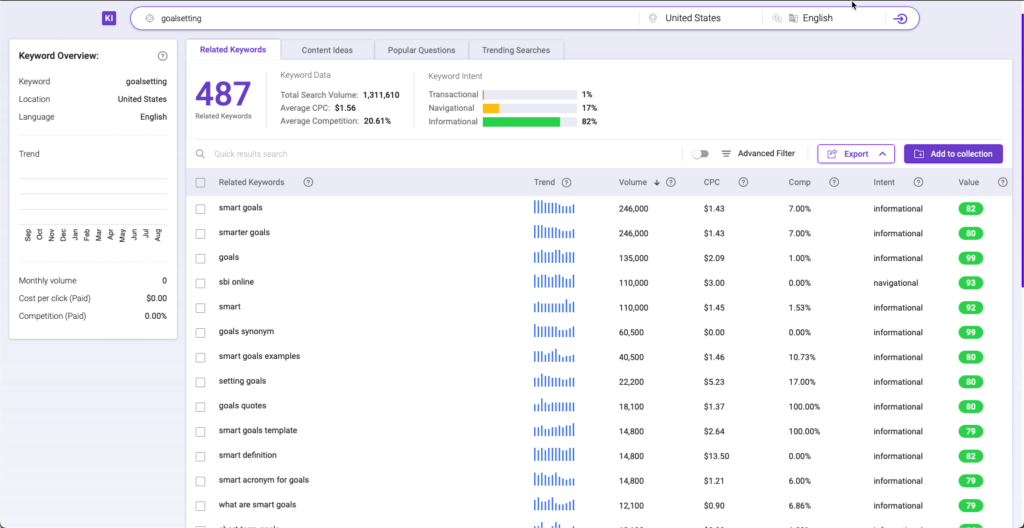

Screenshot of Team BiQ’s Keyword Intelligence Tool
Team BiQ also has an extension called LiveKeyword that you can install on Google Chrome. This allows you to find the most common keyword phrases associated with the keyword you used when searching online.
This will give you better insight into your target audience’s search intent for the keyword phrase you used.
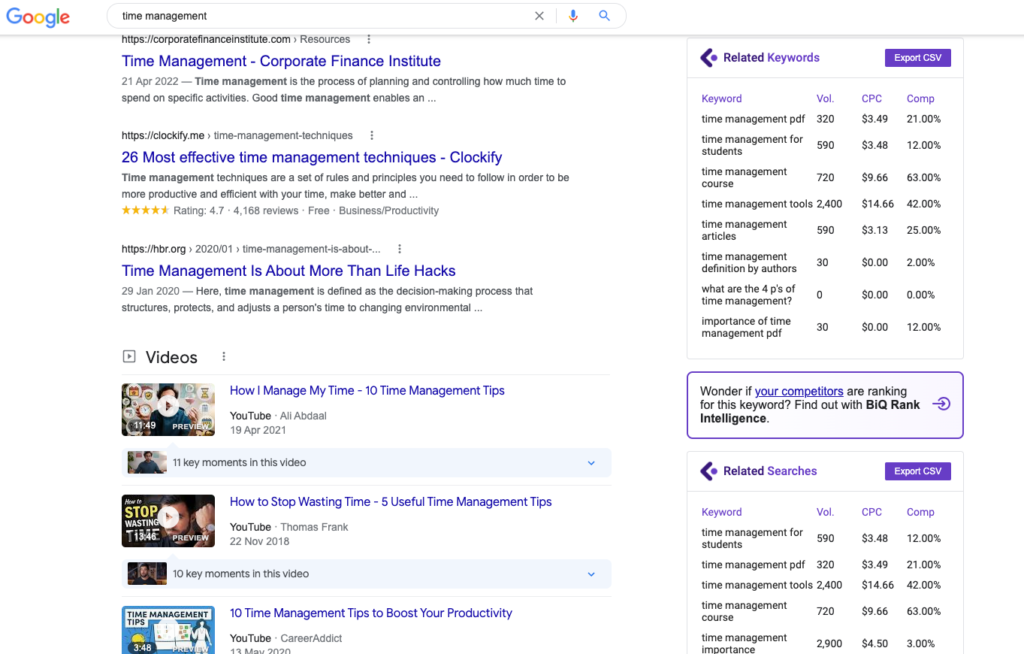

Screenshot of Team BiQ’s Live Keyword Chrome Extension in action
Step #8: Plan Out Your Editorial Calendar
Publishing consistently is key to a successful content marketing strategy. It ensures that you’re regularly providing your target audience with content that’s helpful and packed with information.
More importantly, it also helps build your credibility among potential clients.
Think about it.
If you promised your email subscribers that you’ll send them helpful content every week and you don’t, those potential leads in your email list will have second thoughts about doing business with you.
The challenge, however, is that creating quality content takes time. It can take a writer anywhere from two hours to an entire day to write up a 1,500-word blog post from start to finish.
That said, make sure that you take the time to meet with your content creation team when you plot out your editorial calendar. This will ensure that you stay consistent when publishing quality content on your website.
Step #9: Determine Your Content Distribution Channels
No matter how amazing your content is, it won’t do you or your business any good if your target audience gets to see it.
That said, one of the common mistakes that most B2B content marketers make is that they distribute their content on every social media platform and marketing channel they can think of.
Yes, that approach can get eyeballs to the content your team worked so hard to produce. But unless you have a huge team to handle your content marketing strategy, you won’t be able to maximize the potential of all the distribution channels you’re using.
That’s why I recommend my content marketing clients limit distributing their content to the top three channels their target audience uses. That way, they can master crafting captions and messages that will get their target audience’s attention and pique their curiosity.
This also gives you and your team time to actively engage with your target audience in these channels. Doing this will help you win your target audience’s trust and, eventually, get them to become your clients.
Step #10: Document Your Content Marketing Strategy
As your business grows, you’ll need to bring in more people to help manage your content marketing campaigns.
Documenting your content marketing strategy will ensure that every content you publish has a consistent tone, personality, and quality.
Key Takeaways
This guide covers the basics to help you create and launch a B2B content marketing strategy that delivers results.
I admit that this is a lot to take in. So, I recommend bookmarking this blog post on your browser. That way, you can keep returning to it as you go through the entire process.
Even then, what I shared here is only the tip of the iceberg when creating and managing a content marketing strategy. There’s still so much involved in the process, which I will share in the coming weeks.
B2B content marketing is just like playing chess. Learning the basics takes a short time but a lifetime to master.
Of course, there are ways to fast-track the process. Hiring a content marketing consultant specializing in B2B content marketing is one of them.
If that’s something you’re interested in, I’d love to help you. Schedule a call with me today, and we can chat more about it.